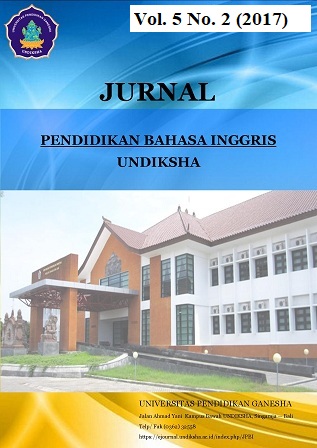AFFIXATION OF MENYALI DIALECT: A DESCRIPTIVE STUDY
DOI:
https://doi.org/10.23887/jpbi.v5i2.15258Abstract
Penelitian ini bertujuan untuk: 1) menemukan imbuhan yang terdapat pada dialek Menyali, 2) mendeskripsikan imbuhan dalam Menyali dialek yang memiliki proses derivation (imbuhan yang mengubah kelas kata), dan 3) mendeskripsikan imbuhan dalam Menyali dialek yang memiliki proses inflection (imbuhan yang tidak mengubah kelas kata). Penelitian ini merupakan penelitian deskriptif dengan pendekatan kualitatif. Terdapat tiga sampel informan yang dipilih berdasarkan kriteria yang ditetapkan. pengumpulan data didasarkan pada teknik observasi, perekaman, dan wawancara. Instrumen yang digunakan untuk mengumpulkan data adalah peneliti, perekam digital, kamera, dan daftar pertanyaan. Terdapat tiga tahap dalam menganalis data yaitu reduksi data, penyajian data, dan penarikan kesimpulan/verifikasi. Hasil dari penelitian ini menunjukan terdapat empat jenis awalan {N-, ma-, pa-, ka-}, tiga jenis akhiran {-in, -ang, -e}, dan dua jenis awalan-akhiran {N-ang; ma-an} dalam dialek Menyali. Awalan dan akhiran dalam dialek Menyali yang merupakan proses derivation yaitu awalan {N-, ma-, pa-, ka-}dan akhiran {-in, -ang, -e}. Awalan dan akhiran dalam dialek Menyali yang merupakan proses inflection yaitu awalan {N, ma-} dan akhiran {-in, -ang, -e}.Kata Kunci : awalan dan akhiran, bahasa Bali di Menyali, proses derivation, proses inflection
This study aimed at: 1) finding the forms of affixes in Menyali dialect, 2) describing the affixes in Menyali dialect that belongs to derivational process, and 3) describing the affixes in Menyali dialect that belongs to the inflectional process. This research employed a descriptive study by using qualitative approach. There were three informant samples chosen based on a set of criteria. The obtained data were collected based on observation, recording, and interview techniques. The instruments used to collect the data were the researcher, digital recorder, camera, and question list. There were three steps of analyzing the data, those were: data reduction, data display, and conclusion drawing/verifying. The results of this study show that there were four kinds of prefixes {N-, ma-, pa-, ka-}, three kinds of suffixes {-in, -ang, -e}, and two circumfixes {N-ang; ma-an} found in Menyali dialect. Prefixes and suffixes in Menyali dialect that have derivational process were prefix {N-, ma-, pa-, ka-} and suffix {-in, -ang, -e}. Prefixes and Suffixes in Menyali dialect that have inflectional process were prefix {N, ma-} and suffix {-in, -ang, -e}.
keyword : prefixes and suffixes, Balinese language in Menyali, morphological derivational, morphological inflectional
Published
2018-07-27
Issue
Section
Articles
License
Authors who publish with the Jurnal Pendidikan Bahasa Inggris Undiksha agree to the following terms:- Authors retain copyright and grant the journal the right of first publication with the work simultaneously licensed under a Creative Commons Attribution License (CC BY-SA 4.0) that allows others to share the work with an acknowledgment of the work's authorship and initial publication in this journal
- Authors are able to enter into separate, additional contractual arrangements for the non-exclusive distribution of the journal's published version of the work (e.g., post it to an institutional repository or publish it in a book), with an acknowledgment of its initial publication in this journal.
- Authors are permitted and encouraged to post their work online (e.g., in institutional repositories or on their website) prior to and during the submission process, as it can lead to productive exchanges, as well as earlier and greater citation of published work. (See The Effect of Open Access)













